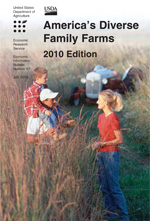America’s Diverse Family Farms, 2010 Edition
by
Robert Hoppe, David E. Banker, and
James MacDonaldEconomic Information Bulletin No. (EIB-67) 12 pp, July 2010
 American farms vary widely in size and other characteristics, but farming is still an industry of family businesses. Ninety-eight percent of farms are family farms, and they account for 82 percent of farm production. Small family farms make up most of the U.S. farm count and hold the majority of farm assets, but they produce a modest share of U.S. farm output. In contrast, large-scale family farms and nonfamily farms—only 12 percent of all farms—account for 84 percent of farm production. Small farms are less profitable than large-scale farms, on average, and the households operating them tend to rely on off-farm income for their livelihood. Because small-farm households receive most of their income from off-farm work, general economic policies—such as tax policy or economic development policy—can be as important to them as traditional farm policy.
American farms vary widely in size and other characteristics, but farming is still an industry of family businesses. Ninety-eight percent of farms are family farms, and they account for 82 percent of farm production. Small family farms make up most of the U.S. farm count and hold the majority of farm assets, but they produce a modest share of U.S. farm output. In contrast, large-scale family farms and nonfamily farms—only 12 percent of all farms—account for 84 percent of farm production. Small farms are less profitable than large-scale farms, on average, and the households operating them tend to rely on off-farm income for their livelihood. Because small-farm households receive most of their income from off-farm work, general economic policies—such as tax policy or economic development policy—can be as important to them as traditional farm policy.
Keywords: Family farms, farm businesses, farm financial performance, farm-operator household income, farm operators, farm structure, farm type, Government payments, limited-resource farms, small farms
In this publication...
Charts and graphs (in .png format) from this report are available in the .zip file listed below. The .zip file also contains a document (readme.txt) that lists the name and title of each chart or graph file.
Need help with PDFs?
Order this Publication